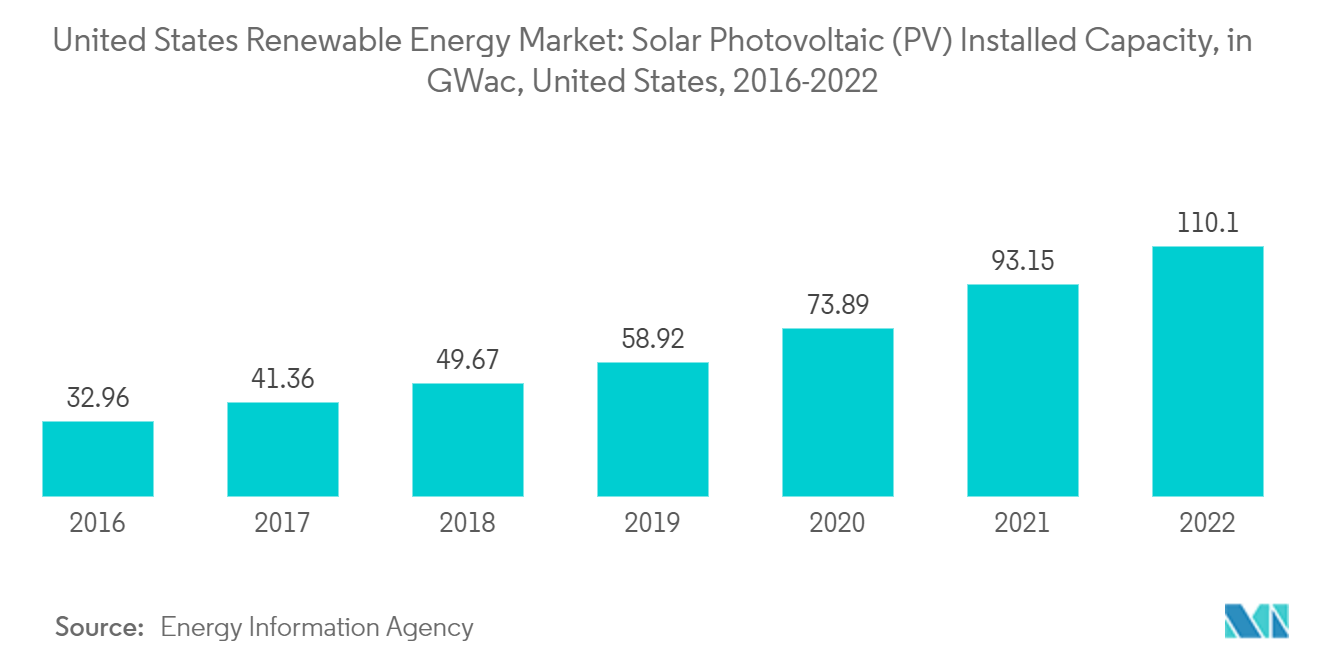Market Trends of United States Renewable Energy Industry
Solar Energy to Witness Significant Growth
- The United States has a vast solar resource potential, with many regions receiving high levels of sunlight throughout the year. This abundance of solar resources makes solar energy a highly attractive option for generating electricity.
- The United States generates almost 23% of its energy needs by using coal and other products. Renewable energy sources like solar energy are likely to thrive more in the near future, mainly due to the transition to cleaner power generation sources and the climate goals in recent years to achieve carbon neutrality.
- In 2021, the United States introduced the Federal Sustainability Plan (FSP), which outlines an ambitious path to power Federal facilities with 100% carbon pollution-free electricity (CFE), including 50% on a 24-hour-a-day, 7-days-a-week (24/7) basis. In order to achieve this ambitious target, the National Renewable Energy Laboratory (NREL), the national laboratory of the Department of Energy, expects a significant increase in solar energy sources.
- For instance, First Solar Inc. and Scout Clean Energy signed a deal in May 2022, wherein First Solar agreed to provide Scout Clean Energy with 378 megawatts (MW) DC of cutting-edge, environmentally conscious thin-film photovoltaic (PV) solar modules.
- In January 2023, BP PLC announced that the construction of the Arche solar project had started, with a capacity of 134 megawatts DC (107 MW AC) currently underway in Fulton County, Ohio. Arche has successfully obtained a Power Purchase Agreement with Meta. When operating at maximum capacity, the project's renewable energy generation has the potential to prevent over 155,900 metric tons.
- According to the US Solar Energy Industries Association, in 2022, the United States witnessed the installation of 17 gigawatts (GWac) of solar photovoltaic (PV) capacity, resulting in a total installed capacity of 110.1 GWdc. Notably, solar energy constituted 50% of all newly added electricity-generating capacity in the United States during the same year.
- Therefore, increasing investments in the sector are expected to drive the US renewable energy market during the forecast period.

Supportive Government Policies to Drive Market Demand
- Government policies, such as tax credits, grants, and subsidies, can significantly reduce the upfront costs of renewable energy installations. These incentives make renewable energy projects more financially viable and attractive to investors, driving market growth.
- For instance, in March 2023, the US Department of Agriculture (USDA) revealed that starting from April 1, applications would be accepted for grants worth USD 1 billion. These grants specifically aim to assist agricultural producers and rural small businesses in investing in renewable energy systems and implementing energy-efficiency improvements.
- Moreover, the US commitment to international climate agreements, such as the Paris Agreement, is expected to drive the domestic renewable energy market's growth. Meeting emissions reduction targets requires a significant increase in renewable energy deployment, leading to supportive policies and actions at the national level.
- In 2021, the United States committed to achieving a 50-52% reduction in greenhouse gas pollution compared to 2005 levels by 2030. The United States has also pledged to transition to a carbon-neutral economy by 2050.
- With these supportive policies, the installed capacities of renewable energy have grown significantly in recent years in the country. According to the Information Energy Administration, the electricity generated through renewable energy was around 1689.44 TWh, an increase of around 5.5% compared to 2021. This capacity is expected to increase further due to various auctions conducted by the government for renewable energy.
- For instance, in February 2022, the United States conducted one of the biggest auctions for renewable energy at USD 1.5 billion on offshore wind sites in the country. Development of all six projects has the potential of generating as much as 7 GW of wind energy, which can power two million American homes.
- Therefore, supportive government policies are expected to drive the renewable energy market in the United States during the forecast period.


